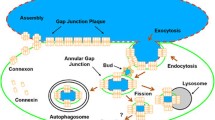Abstract
Antibodies against 21 and 27 kDa gap-junction proteins from rat liver were used to examine the identification and localization of gap-junction proteins in rat salivary glands. Acinar cells of the submandibular glands and parotid glands stained well for the 27 kDa gap junction protein and less intensely for the 21 kDa protein. Acinar cells of the sublingual glands were stained heavily for the 27 kDa gap junction protein and stained well for 21 kDa gap junction protein. No 27 kDa protein was observed in the ducts of the salivary glands. The 21 kDa gap-junction protein was distributed in some of the intercalated ducts in the parotid and submandibular glands. Immunoblotting of an extract of parotid glands with antibodies against 21 and 27 kDa gap-junction proteins revealed the presence of 21 and 27 kDa proteins in the parotid glands. It is concluded that the 27 kDa gap-junction protein in tistributed as a major component of the gap junctions in the acinar cells of all the salivary glands; the 21 kDa protein is localized as a minor component in the acinar cells and some portions of the intercalated ducts in the salivary glands. It is possible that these gap-junction proteins might contribute to the regulation of function of the salivary glands.
Similar content being viewed by others
References
Barrio LC, Suchyna T, Bargiello T, Xu LX, Roginski RS, Bennett MVL, Nicholson BJ (1991) Gap junctions formed by connexins 26 and 32 alone and in combination are differently affected by applied voltage. Proc Natl Acad Sci USA 88:8410–8414
Case RM, Conirave AD, Novak I, Young JA (1980) Electrolyte and protein secretion by the perfused rabbit mandibular gland stimulated with acetylcholine or catecholamines. J Physiol (Lond) 300:467–487
Dermietzel R, Leibstein A, Frixen U, Janssen-Timmen U, Traub O, Willecke K (1984) Gap junctions in several tissues share antigenic determinants with liver gap junctions. EMBO J 3:2261–2270
Dewey MM, Barr L (1964) A study of the structure and distribution of the nexus. J Cell Biol 23:553–585
Dunn J, Revel J-P (1984) Association of gap junctions with endoplasmic reticulum in rat parotid glands. Cell Tissue Res 238:589–594
Evans WH (1994) Hiroshima welcomes gap junction communicants. Trends Cell Biol 4:26–29
Findlay I, Petersen OH (1983) The extent of dye-coupling between exocrine acinar cells of the mouse pancreas. The dyecoupled acinar unit. Cell Tissue Res 232:121–127
Friend DS, Gilula NB (1972) Variations in tight and gap junctions in mammalian tissues. J Cell Biol 53:758–776
Gallacher DV, Petersen OH (1983) Stimulus-secretion coupling in mammalian salivary glands. Int Rev Physiol 28:1–52
Hammer MG, Sheridan JD (1978) Electrical coupling and dye transfer between acinar cells in rat salivary glands. J Physiol (Lond) 275:495–505
Hertzberg EL (1984) A detergent-independent procedure for the isolation of gap junctions from rat liver. J Biol Chem 259:9936–9943
Hertzberg EL, Gilula NB (1979) Isolation and characterization of gap junctions from rat liver. J Biol Chem 254:2138–2147
Hertzberg EL, Skibbens RV (1984) A protein homologous to the 27000 dalton liver gap junction protein is present in a wide variety of species and tissues. Cell 39:61–69
Iwatsuki N, Petersen OH (1978) Pancreatic acinar cells: acetylchholine-evoked electrical uncoupling and its ionic dependency. J Physiol (Lond) 274:81–96
Kanno Y, Loewenstein WR (1964) Low-resistance coupling between gland cells. Some observations on intercellular contact membranes and intercellular space. Nature 201:194–195
Kater SB, Galvin NJ (1978) Physiological and morphological evidence for coupling in mouse salivary gland acinar cells. J Cell Biol 79:20–26
Meda P, Bruzzone R, Knodel S, Orci L (1986) Blockage of cellto-cell communication within pancreatic acini is associated with increased basal release of amylase. J Cell Biol 103:475–483
Meda P, Chanson M, Peper M, Giordano E, Bosco D, Traub O, Willecke K, Aoumari A, Gros D, Beyer EC, Orci L, Spray DC (1991) In vivo modulation of connexin 43 gene expression and junctional coupling of pancreatic B-cells. Exp Cell Res 192:469–480
Nagato T, Tandler B (1986) Gap junctions in rat sublingual gland. Anat Rec 214:71–75
Nauntofte B, Dissing S (1987) Stimulation-induced changes in cytosolic calcium in rat parotid acini. Am J Physiol 253:G290-G297
Petersen OH (1986) Potassium channels and fluid secretion. News Physiol Sci 1:92–95
Sasaki Y, Shiba Y, Kanno Y (1988) Suppression of intercellular communication in acinar cells from rat submandibular gland by cholinergic and adrenergic agonists. Jpn J Phsiol 38:531–543
Spearman TN, Pritchard ET (1977) Potassium release from submandibular salivary gland in vitro. Biochim Biophys Acta 466:198–207
Traub O, Look J, Dermietzel R, Brummer F, Wilser D, Willecke K (1989) Comparative characterization of the 21-kD and 26-kD gap junction proteins in murine liver and cultured hepatocytes. J Cell Biol 108:1039–1051
Yamamoto M, Kataoka K (1988) An electron microscope study of the development of the exocrine and endocrine pancreas with special reference to intercellular junctions. Arch Histol Cytol 51:315–325
Young JA, Cook DI, Van Lennep EW, Roberts ML (1987) Secretion by the major salivary glands. In: Johnson L, Christensen J, Jackson M, Jacobson E, Walsh J (eds) Physiology of the gastrointestinal tract, vol 2, 2nd edn. Raven Press, New York, pp 773–815
Zhang J-T, Nicholson BJ (1989) Sequence and tissue distribution of a second protein of hepatic gap junctions, Cx26, as deduced from its cDNA. J Cell Biol 109:3391–3401
Author information
Authors and Affiliations
Rights and permissions
About this article
Cite this article
Hirono, C., Shiba, Y. & Kanno, Y. Different localizations of 21 and 27 kDa gap-junction proteins in rat salivary glands. Histochem Cell Biol 103, 39–46 (1995). https://doi.org/10.1007/BF01464474
Accepted:
Issue Date:
DOI: https://doi.org/10.1007/BF01464474



